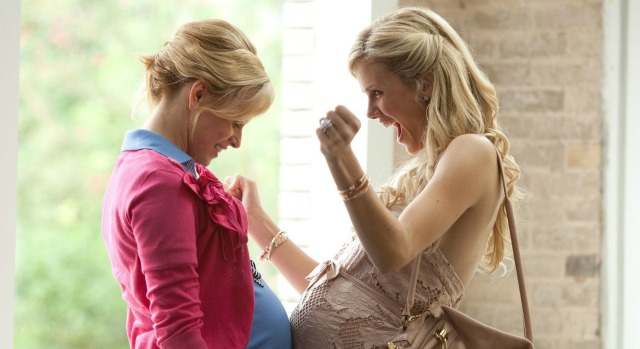Childbirth Hollywood Style

Okay, it’s a comedy. But does the most recent pregnancy-themed film have to trivialize women by ignoring any and all real issues about giving birth?
If Hollywood is to be believed, pregnancy and childbirth is a hilarious vehicle for comedy and nothing more. Whether audiences are being asked to laugh at Katherine Heigel’s misery in "Knocked Up," or Kristen Wiig’s marriage-destroying depression in "Friends With Kids," it’s clear that the media is uncomfortable taking women’s lives and bodies seriously—and the pregnancy-themed film released this month, "What To Expect When You’re Expecting," is no departure from this trend.
Centred around the conception-, pregnancy- and childbirth-related struggles of five couples, the film not only contains every tired cliché about pregnancy but also neatly disregards the millions of women in this country and worldwide for whom having children can be a life or death matter. Four of the lead women are white, and all five are slim, impossibly young-looking, and of course, heterosexual. With perhaps a slight bow to reality, the only Latina—Holly, played by Jennifer Lopez —is also the only woman to experience any financial struggles, as she undergoes a brief moment of panic when she loses her somewhat implausible job as a photographer. Apart from this, though, none of the women worry about money, especially not health insurance or childcare costs. Twenty percent of women in the United States live without health insurance—but this one in five women’s situation is represented by none of the five women in the movie.
Women of color are largely absent from the movie, appearing as sassy overweight nurses or motherly doctors. The movie does touch on the prospect of maternal mortality, with Elizabeth Banks’ character Wendy suffering blood loss after a C-section, but after a few tense moments, she has magically recovered. Such is not the case for many women in America, nor in the developing world. But in "What To Expect," maternal mortality is simply used as a source of tension to manipulate the audience’s emotions, rather than being acknowledged as a major killer of women—particularly black women, who are nearly four times more likely to die in childbirth than their white counterparts.
The movie’s unwillingness to acknowledge poor or black women continues when Holly and her partner Alex adopt an Ethiopian baby but the infant’s background is left unexplored. Statistics tell us that an African pregnant woman has a 1 in 13 chance of dying in childbirth so Holly and Alex’s opportunity to adopt may well have emerged from this deadliest of trends. Alternatively, their adopted son could have been one of the 16.6 million children orphaned by AIDS, most of whom live in sub-Saharan Africa, but all that mattered in the movie was that the rich Western couple got themselves a baby.
The cocooned world that surround the storylines is so divorced from the reality that most women live, it’s almost comical. When Rosie, a food truck worker, becomes pregnant after a one night stand with a fellow employee, there is barely even an allusion to abortion—a few tense words pass between the two stressed twentysomethings, but we soon see the couple nestling together and admiring Rosie’s growing belly. Abortion, something 1 in 3 American women will go through in their lifetimes, remains the taboo filmmakers do not want to touch. Female characters in movies are given the sole option of being totally fulfilled by a pregnancy—even if, as in Rosie’s case, it is unplanned, unwanted, and both partners are low-income young people—and the idea of a woman taking the reasonable step to end a pregnancy is apparently still too shocking for audiences.
But inserting any realistic scenes would clearly detract from a movie that plays women, who are generally depicted as neurotic, shrill and entirely self-absorbed, entirely for laughs. It’s apparently hilarious that Elizabeth Bank’s character is suffering from bladder weakness during her pregnancy, but I’m sure few pregnant women would agree that it’s actually funny in real life. You could say the film is demystifying pregnancy, but it’s more accurate to say that it is just turning women’s health into a circus sideshow. And why directors so dearly love showing women screaming in labor I’ll never know, but it’s always seemed deeply perverse to me. Is there any other context in which viewers would find it hilarious to see a woman deeply distressed and in massive amounts of pain?
Yet filmmakers apparently believe it’s fine to treat pregnancy and childbirth as a joke, because it’s just some cute episode that makes women crazy for a while, before an inevitable happy ending. It’s fine to show emaciated white women looking perfectly manicured while sporting miniscule bumps, but the brutal reality of a society where women are now fighting for the right to birth control, abortion and decent healthcare is nowhere to be found. No cheap laughs excuse a movie that trivialises women so much.
More articles by Category: Arts and culture, Health, International, Race/Ethnicity
More articles by Tag: Reproductive rights



























